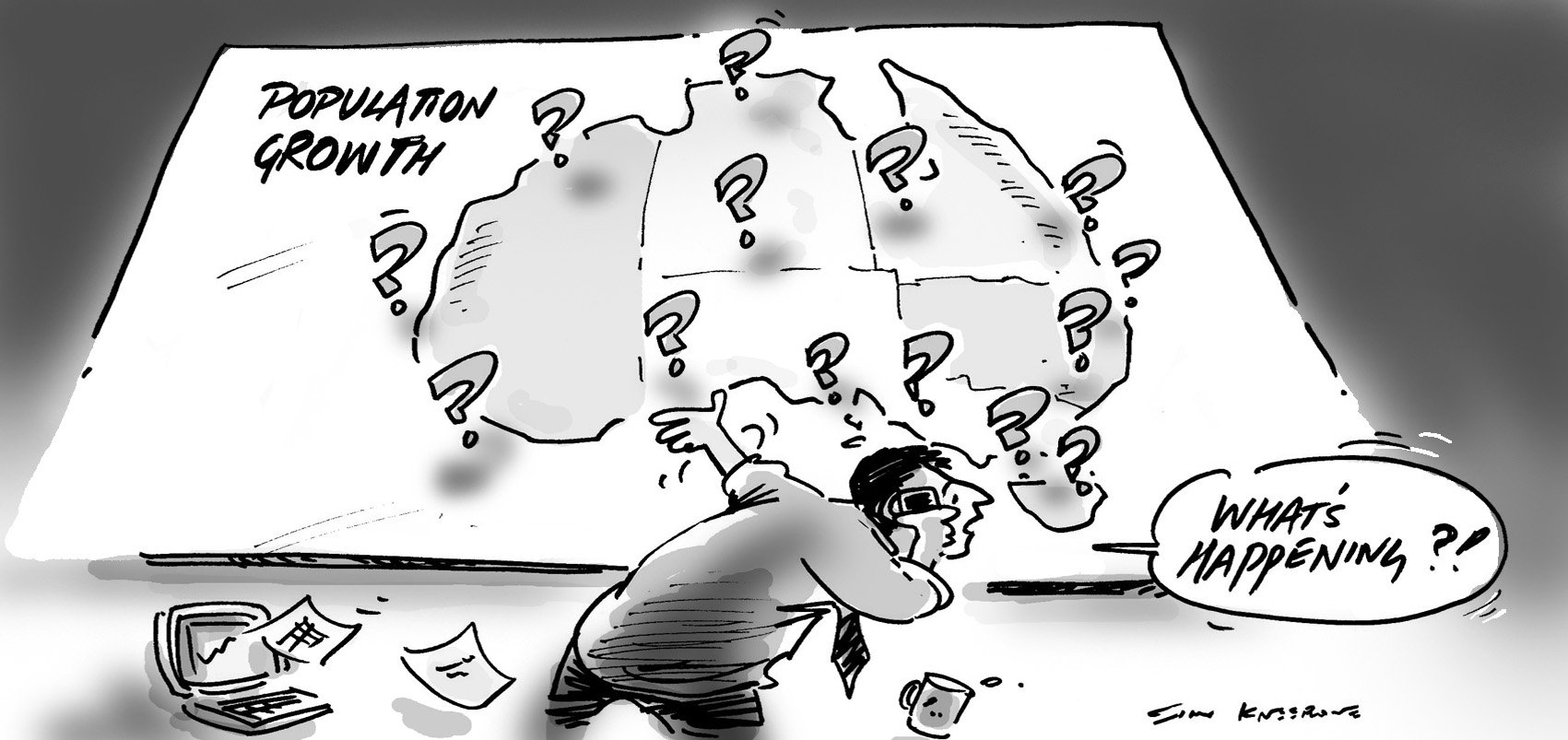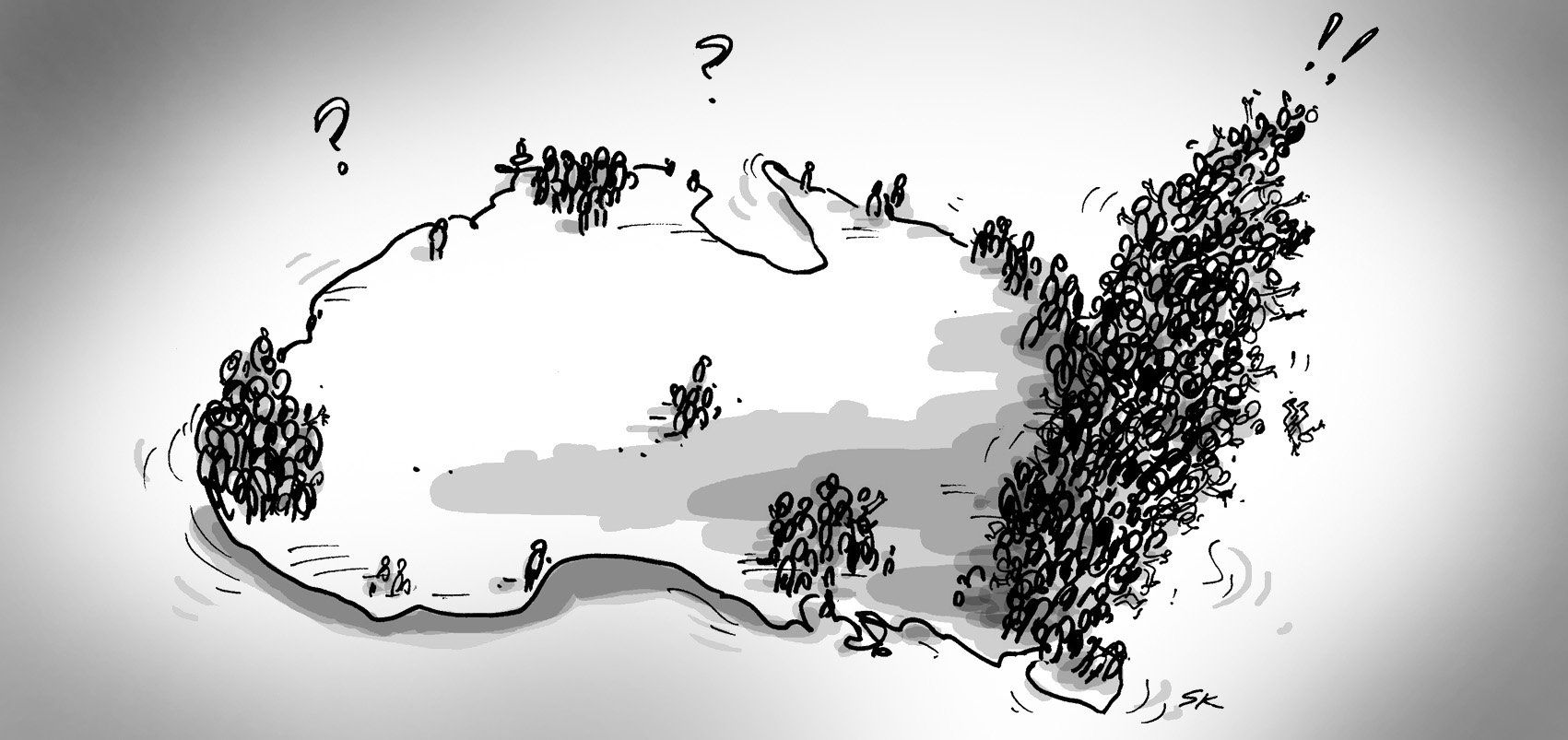BLOG
Melbourne and Sydney populations fall while regional areas grow
Melbourne and Sydney populations fall while regional areas grow
Glenn looks at the annual population update for Local Government Areas, continuing the story of population loss in our largest cities and population growth in regional areas. Read to the end to understand how this data will be reviewed in light of the upcoming Census data release!
The ABS have just released Regional Population Growth, 2020-21, their annual population update for Local Government Areas and smaller places. These will be updated very soon on the .id sites. We know the population updates are eagerly awaited each year, and this year particularly so. The 2020–21 year is the first full COVID-affected year, with border closures, lockdowns etc. And this drove the national population to increase by just 0.18% for the year ended June 2021. That’s the lowest growth rate since World War I, but the real issue is how this plays out regionally – and it’s a very interesting story indeed.
Capital cities are (mostly) shrinking, Regional Australia is growing
At a Capital City level, the effect of the pandemic is most clearly seen: the combined capital cities of Australia lost a total of 25,985 people for the year. Melbourne accounted for most of this, down by 60,505 people, while Brisbane and Perth both grew. Sydney shrunk a little (-5,151) and Adelaide was stable, but Melbourne’s loss amounts to a 1.2% decline in population in a year, which has never been seen before. This is at June 30th, 2021, which predates Lockdowns 5 and 6 in Melbourne. Melbourne’s loss is mainly due to out-migration, both overseas (-54,367) as well as interstate and regionally (-33,501). Sydney saw similar migration losses within Australia (-34,849) but much lower overseas migration loss (-7,245), so their total population change was only slightly negative at -0.1%.
Brisbane’s growth of 21,870 people is less than half that seen in the previous year, but it still accounts for a 0.9% increase. This just happens to be the same total population growth as Regional Australia (the area outside the greater capital cities). The regions added 70,900 people, or 0.9%. For comparison, in 2019–20 regional areas grew by 1.1%, so the overall level of population growth outside the capitals is barely affected.
Growth in our largest centres has been at the expense of the regions for some time, but COVID has totally turned the tables on this, and now Regional Australia is growing while the capital cities are shrinking (but mainly Sydney and Melbourne). The ABS has never before recorded a larger population growth outside our capital cities than within them (since ERP started in 1981). This is because the exodus to overseas has been from the areas which attracted the migrants in the first place: our capital cities. Other factors include less (mainly young) people moving out of Regional Areas to go to the capitals, plus “fleechange” migration outwards to work from home and avoid lockdowns, which have been longer and tougher in our largest cities.
Capital City population change 2020–21
| Greater Capital City | ERP at 30 June 2021 | 2020-21 (no.) | 2020–21 (%) |
|---|---|---|---|
| Sydney | 5,361,466 | -5,151 | -0.10% |
| Melbourne | 5,096,298 | -60,505 | -1.19% |
| Brisbane | 2,582,007 | +21,870 | +0.85% |
| Adelaide | 1,378,413 | +1,895 | +0.14% |
| Perth | 2,141,834 | +16,169 | +0.75% |
| Hobart | 238,375 | -334 | -0.14% |
| Darwin | 146,982 | -327 | -0.22% |
| Canberra | 431,611 | +398 | +0.09% |
| Total capital cities | 17,376,986 | -25,985 | -0.15% |
Analysis is below, but here is a map showing the percentage population growth in the past year (2020-21) so you can find your own area.
Changes by LGA show the growth in metropolitan fringe
Despite Victoria's population decline topping the nation, 5 of the top 10 fastest growing LGAs are in Victoria! Four of these are regional, and represent the movement to lifestyle areas beyond the metropolitan fringe, particularly places like Surf Coast, Bass Coast and Baw Baw Shire.
Top 10 fastest growing LGAs 2020–21
| Local Government Area | 2020 | 2021 | Change (no.) | Change (%) | |
|---|---|---|---|---|---|
| 1 | Camden NSW | 107,797 | 114,516 | 6,719 | 6.2% |
| 2 | Surf Coast Vic | 34,761 | 36,278 | 1,517 | 4.4% |
| 3 | Melton Vic | 172,398 | 179,107 | 6,709 | 3.9% |
| 4 | Bass Coast Vic | 37,439 | 38,825 | 1,386 | 3.7% |
| 5 | Maitland NSW | 87,393 | 90,449 | 3,056 | 3.5% |
| 6 | Serpentine-Jarrahdale WA | 33,927 | 35,087 | 1,160 | 3.4% |
| 7 | Mitchell Vic | 47,627 | 49,216 | 1,589 | 3.3% |
| 8 | Mount Barker SA | 37,741 | 38,975 | 1,234 | 3.3% |
| 9 | Baw Baw Vic | 54,866 | 56,583 | 1,717 | 3.1% |
| 10 | Kwinana WA | 46,798 | 48,212 | 1,414 | 3.0% |
Topping the list of fastest growing areas overall, however is Camden (an old favourite in this list). The new housing area on the south-western edge of Greater Sydney benefits from both urban migration to new housing on the fringe, and some lifestyle movement due to its semi-rural nature. The ability to Work From Home benefits outer suburban as well as regional areas at the expense of inner cities.
The other side of the table is those LGAs showing population decline. This would normally be dominated by small population remote LGAs. In 2021, a total of 232 of Australia's 539 LGAs recorded population decline; 9 of the 10 largest falls are all large population LGAs in established suburban areas of Melbourne. The City of Melbourne itself sits at #1, losing 7.5% of population as a result of a loss of overseas migrants, largely students. This was a topic of debate late last year when the inner city's vaccination rate was the lowest in the nation: part of this was that the denominator used for the calculation was an older population estimate, close to 10% higher than the population present at the time.
Top 10 fastest declining LGAs 2020-21
| Local Government Area | 2020 | 2021 | Change (no) | Change (%) | |
|---|---|---|---|---|---|
| 1 | Melbourne Vic | 183,628 | 169,860 | -13,768 | -7.5% |
| 2 | Port Phillip Vic | 116,417 | 112,092 | -4,325 | -3.7% |
| 3 | Stonnington Vic | 118,567 | 114,340 | -4,227 | -3.6% |
| 4 | Boroondara Vic | 182,974 | 176,632 | -6,342 | -3.5% |
| 5 | Monash Vic | 204,845 | 197,980 | -6,865 | -3.4% |
| 6 | Yarra Vic | 103,076 | 99,622 | -3,454 | -3.4% |
| 7 | Brimbank Vic | 208,147 | 201,680 | -6,467 | -3.1% |
| 8 | Greater Dandenong Vic | 168,267 | 163,266 | -5,001 | -3.0% |
| 9 | Whitehorse Vic | 180,664 | 175,970 | -4,694 | -2.6% |
| 10 | Sydney NSW | 248,668 | 242,237 | -6,431 | -2.6% |
The fastest declines are clearly in the inner areas of Melbourne, such as Yarra, Port Phillip, Stonnington and Boroondara; and then a bit further out into the established areas such as Whitehorse and Brimbank. Rounding out the top 10 is the City of Sydney, which has had declines similar to Melbourne caused by overseas students leaving, but NSW was less affected overall. Note that the recently released State figures for September 2021 are after this time period, and show stronger loss from NSW associated with the lockdown there.
And yet, there are other areas of Melbourne clearly growing strongly. Generally, outer suburbs still show population growth, including places such as Melton, Wyndham, Casey, Cardinia and Hume. The pandemic in Melbourne seems to be leading to a hollowing out of the metropolitan area, similar to the "doughnut city" population movement which characterised the 1980s. It is evident in other areas as well. COVID lockdowns and WFH trends push people outwards within metropolitan areas, and more towards the regions – particularly lifestyle areas within an hour or two drive from the capitals.
For those of you in Queensland, you may be wondering why, with the remarkable population growth, there are no areas from the Sunshine State appearing in the top 10 growth list above. Ipswich just misses out when ranked by percentage (11th), and if we instead rank the numerically largest growth rather than percentage, we see that the top 4 LGAs are all from Queensland. This state has the largest LGAs by population so they tend not to be "fast" growing in percentage terms due to a large population base to begin with.
Top 10 largest growing LGAs (numerical growth), 2020–21
| Local Government Area | 2020 | 2021 | Change (no) | Change (%) | |
|---|---|---|---|---|---|
| 1 | Gold Coast Qld | 635,058 | 643,461 | 8,403 | 1.3% |
| 2 | Sunshine Coast Qld | 336,444 | 343,590 | 7,146 | 2.1% |
| 3 | Moreton Bay Qld | 479,576 | 486,645 | 7,069 | 1.5% |
| 4 | Ipswich Qld | 229,798 | 236,708 | 6,910 | 3.0% |
| 5 | Camden NSW | 107,797 | 114,516 | 6,719 | 6.2% |
| 6 | Melton Vic | 172,398 | 179,107 | 6,709 | 3.9% |
| 7 | Wyndham Vic | 283,082 | 289,571 | 6,489 | 2.3% |
| 8 | Logan Qld | 341,908 | 348,020 | 6,112 | 1.8% |
| 9 | The Hills NSW | 183,777 | 188,557 | 4,780 | 2.6% |
| 10 | Greater Geelong Vic | 264,783 | 269,508 | 4,725 | 1.8% |
More population data is coming later this year
Regional Population Growth – though important – is not the last population release this year. Data from last year's Census are due for release in June 2022. The population figures in this blog are not based on 2021 Census data, but on updating previous year's population data, accounting for births, deaths and migration. These figures will be revised in the light of 2021 Census data. There is no official date for this yet, but the most likely revision (which includes 5 years of past data adjustments) will be from late July 2022. Last Census, there were quite major adjustments to population numbers. We'll always ensure that the latest version is available in our community profiles for Local Government, but sometimes it can be confusing when these change around during the year. Feel free to get in touch if you have any questions about it. We can also run training and briefings for our clients which go through the differences and what they mean for your area.
Glenn - The Census Expert
Glenn is our resident Census expert. After ten years working at the ABS, Glenn's deep knowledge of the Census has been a crucial input in the development of our community profiles. These tools help everyday people uncover the rich and important stories about our communities that are often hidden deep in the Census data. Glenn is also our most prolific blogger - if you're reading this, you've just finished reading one of his blogs. Take a quick look at the front page of our blog and you'll no doubt find more of Glenn's latest work. As a client manager, Glenn travels the country giving sought-after briefings to councils and communities (these are also great opportunities for Glenn to tend to his rankings in Geolocation games such as Munzee and Geocaching).








